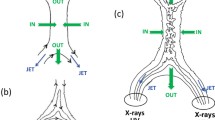Abstract
The RAE (Radio Astronomy Explorer) satellite observed enormous numbers of type III radio bursts at hectometric wavelengths from 13 to 25 August in 1968. The drift rate of these bursts reached a maximum around the middle of 20 August. This means that the source responsible for these bursts gradually moved on the solar disk in association with the rotation of the sun. During this period, there were two large active sunspot groups, MacMath Nos. 9593 and 9597, which were located in the southern hemisphere and adjacent to each other. By examining the observational data on solar flares, type I noise storm activity and energetic electron flux increases, it is shown that the active region, MacMath No. 9597 is responsible for the generation of these type III radio bursts. The relation between type III bursts producing electron beams and type I noise activity is briefly discussed and a model of this active region is qualitatively described.
Similar content being viewed by others
References
Fainberg, J. and Stone, R. G.: 1970a, Type III Solar Radio Burst Storms Observed at Low Frequencies, Part 1: Storm Morphology', Solar Phys. 15, 222.
Fainberg, J. and Stone, R. G.: 1970b, ‘Type III Solar Radio Burst Storms Observed at Low Frequencies, Part 2: Average Exciter Speed’, Solar Phys. 15, 433.
Fokker, A. D.: 1965, ‘Noise Storms’, in J. Aarons (ed.), Solar System Radio Astronomy, Plenum Press, New York, 171.
Kai, K.: 1970, ‘The Structure, Polarization, and Spatial Relationship of Solar Radio Sources of Spectral Types I and III’, Solar Phys. 11, 456.
Kundu, M. R.: 1965, Solar Radio Astronomy, Interscience, New York.
Lin, R. P.: 1970, ‘The Emission and Propagation of Solar Flare Electrons. 1. The Relationship of ~ 40-keV Electron to Energetic Proton and Relativistic Electron Emission by the Sun’, Solar Phys. 12, 266.
Lin, R. P. and Anderson, K. A.: 1967, ‘Electrons > 40 keV and Protons > 500 keV of Solar Origin’, Solar Phys. 1, 446.
McCracken, K. G.: 1962, ‘The Cosmic-Ray Flare Effect. 3. Deductions Regarding the Interplanetary Magnetic Field’, J. Geophys. Res. 67, 447.
Morimoto, M. and Kai, K.: 1961, ‘The Height of the Solar Radio Bursts at 200 Mc/s’, Pub. Astron. Soc. Japan 13, 294.
Sakurai, K.: 1967, ‘Energetic Electrons Associated with Solar Flares’, Publ. Astron. Soc. Japan 19, 316.
Sakurai, K.: 1971, ‘Energetic Electrons Associated with Solar Flares and Their Relation to Type I Noise Activity’, this issue, page 198.
Sakurai, K. and Stone, R. G.: 1970, ‘The Nature of the Active Regions McMath Nos. 9593 and 9597 in August 1968’, Trans. Am. Geophys. Union 51, 416.
Solar-Geophysical Data: 1968, Nos. 289 and 290, U.S. Dept. of Commerce, ESSA.
Takakura, T.: 1963, ‘Origin of Solar Radio Type I Bursts’, Publ. Astron. Soc. Japan 15, 462.
Van Allen, J. A. and Krimigis, S. M.: 1965, ‘Impulsive Emission of ~ 40 keV Electrons from the Sun’, J. Geophys. Res. 70, 5737.
Author information
Authors and Affiliations
Additional information
NAS-NRC Associate with NASA.
Rights and permissions
About this article
Cite this article
Sakurai, K. On the characteristics of the solar active regions responsible for the generation of type III radio bursts at hectometric frequencies in August 1968. Sol Phys 16, 125–134 (1971). https://doi.org/10.1007/BF00154508
Received:
Issue Date:
DOI: https://doi.org/10.1007/BF00154508




